#chinese mythology & folklore
Text

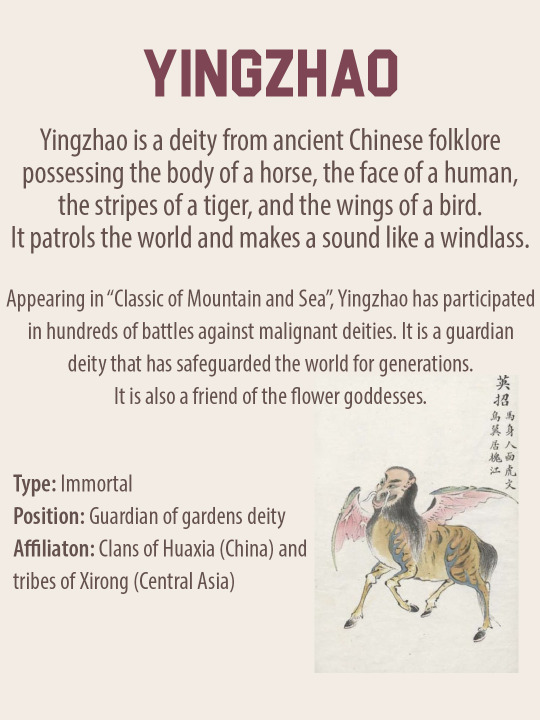
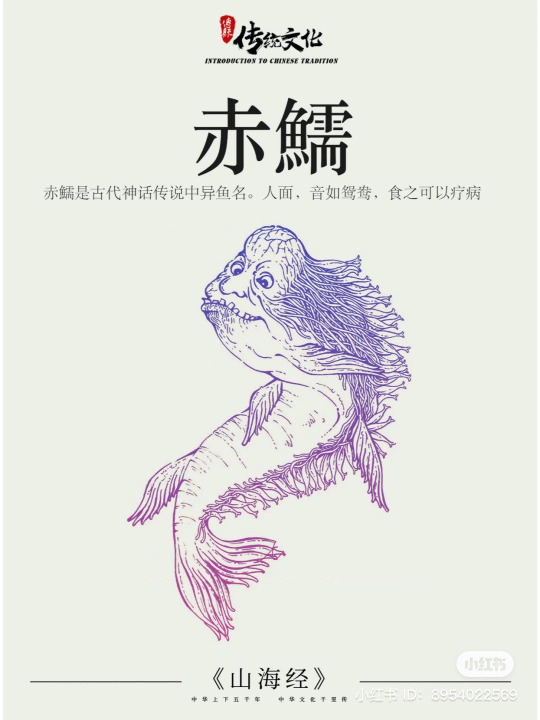

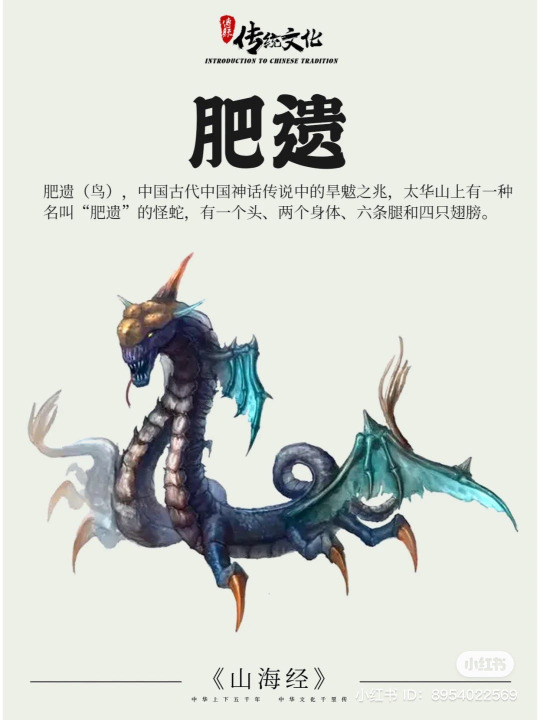

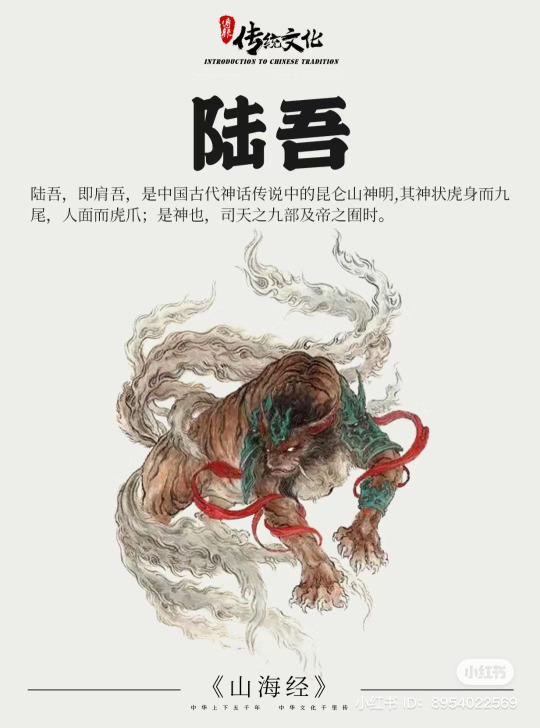
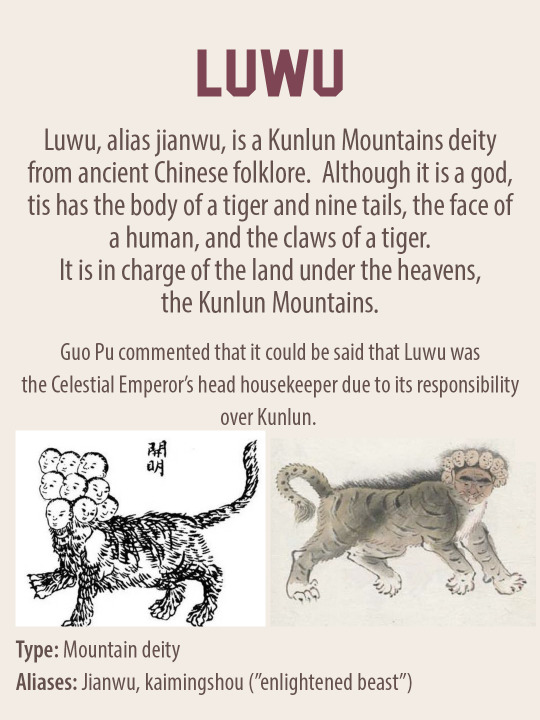
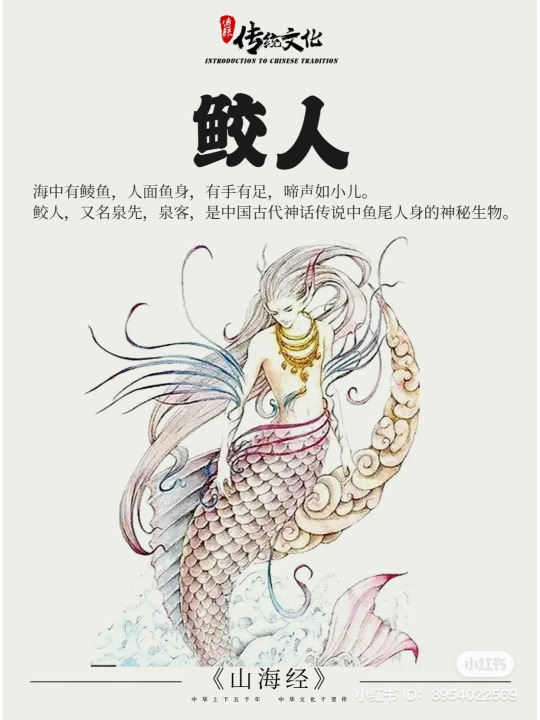

A look at a few mythological beings from 山海经, Classic of Mountain and Sea, compiled beginning around 500 BC with the earliest remaining finished version existing by 200 BC.
Right column graphics created by me, translating the left and adding a few more details.
#chinese folklore#arts#chinese mythology#text#kind of different from what i normally do i guess!#chinese history#mine#if you see any typos in this no you don't bc i didn't either
2K notes
·
View notes
Text

The gang hitch a ride on a friendly turtle.
#Journey to the West#Sun Wukong#Monkey King#Zhu Bajie#Pigsy#Tang Sanzang#Tripitaka#Sha Wujing#Sandy#Chinese mythology#Chinese folklore#turtle
213 notes
·
View notes
Text
Running Commentary: What is “ok to do” in Mixed-Culture Supernatural Fiction?
Dear readers:
Today we are trying something new. To give you some insight into our process in the Japanese moderator section, we are presenting our response in the form of running commentary to show you how we dissect and answer long asks. We hope this makes clear what points are useful and not useful when sending us a query. As always, this is for learning purposes, not callouts. Be prepared: this is a long one.
To summarize: the asker is looking to create a comic drawn in Japanese manga style, and has provided a long summary of the story and worldbuilding which involves a mix of “reimagined” Japanese yokai mythos and cultural symbols from many other sources. They have questions with respect to cultural appropriation, coding etiquette, and “what is and isn’t ok.”
Opening Comments
I know a common advice when it comes to the thing I am about to ask is to talk to people involved in __, but I struggle with opening up to strangers for reasons I'm uncomfortable explaining.
Marika (M): This is already a red flag. If you want to engage with another culture without talking to people from that culture, then research is going to be very challenging. You won’t have members of that culture to guide you towards sources and perspectives they feel most accurately represents public opinion. If I were in your shoes, I might start with tackling my discomfort when engaging with other people, if only to improve my work. If you aren’t ready to engage with a culture and its people directly, then I think you should wait until you are.
I should note, reaching out to the Japanese mod team at WWC does count as engagement, but WWC should not and cannot be the only point of contact because there is no single, legitimate cultural perspective.
Rina (R): Also, you don’t need to “open up” to strangers or talk to them in person to get perspectives. Asking specific research questions anonymously to a forum or on social media requires very little vulnerability. You managed to do it here on WWC. So give it a try!
Anyway, my question basically amounts to the what is and isn't ok [sic] in terms of depicting fantasy creatures and concepts outside of their respective culture.
R: So, the reason why we turn away rubber stamp questions by that ask “is XYZ okay?” is because “okay” & “not okay” 1) is vague and 2) creates a dichotomy where there isn’t one.
When we say something is “not okay,” do we mean:
It’s offensive to the general majority of XYZ group?
It’s contentious among people who ID in the group?
It has a potential to be interpreted in a certain negative way, but may not be a red flag to everyone?
Insetad try asking:
What are the reasons this subject is offensive?
What makes cultural appropriation bad?
When might it be “okay” to intentionally discuss a difficult or controversial topic?
What is your reason for including something that may be interpreted as offensive and can it be sufficiently justified?
What stereotypes or tropes might it be consistently identified as or associated with, and why?
When might it be justified to bring up these tropes?
With That In Mind...
Let’s get into the rest of the ask below.
…a story I've been working on in recent times is largely inspired off the Japanese yokai, and the setting is basically Earth in the far future, as far as when the next supercontinent may form. These yokai, although portrayed differently here, do retain their main characteristics [...] Included in this world are two goddesses of my own creation, primarily representing the sun and the moon. [...] There will be thirteen nations, named and based after the Chinese Zodiac, and the life force found in the living things in this world, called qi, comes in two forms that are always opposing each other but can never fully overpower the other, this being based off yin and yang. They're even directly named this; yin qi and yang qi.
M: This reads more like using Japanese and Chinese culture for the “aesthetics”, not the cultures themselves, which I personally feel falls under cultural appropriation. From a world-building/ coding standpoint, the actual use of concepts is workable, and, dare I say, typical, given how Chinese cosmology influences Japanese culture. However, naming a concept “yin qi” or “yang qi” is the equivalent of naming something “- charge” or “+ charge”, respectively. That you don’t seem aware of this tells me you are pretty early in your research phase. In that vein, we’ve covered translating terms and names from foreign languages in fantasy before. See the following article linked here for our recommendation against using RL terms outright but instead encouraging people to create their own conlangs.
R: Worldbuilding-wise, I think you would have to figure out the chicken-or-egg of the zodiac nations. Did the nations come first, and the zodiac later as an origin folk story (which you would have to rewrite to serve the nation-building narrative)? Did the zodiac come first, and the nations named (most likely re-named) by a political entity? What is the justification? Otherwise, again, it’s a shoehorning of aesthetics.
There is also a third, lesser known god based off of fox spirits and trickery and I imagined he's the patron deity of a family that honors and worships him, but his influence on them has transformed them into Kitsune-tsuki, which I depict as fox-like anthros.
M: Not related to this ask directly, but I have jokingly ranted about how often non-Japanese people prefer using imagery related to kitsune-tsuki in Japanese coded world-building (link). This makes me feel the same level of petty irritation. See my troll answer below for a similar experience.
R: Same. It’s boring tbh.
M: Troll Answer: I get that kitsune-tsuki are very sexy furries, but Japanese folklore has other sexy furries too! These underrepresented demographics also deserve recognition and appreciation!!
The plot of the story is this; modernization has left the goddesses neglected of their worship and forgotten, something that is necessary in this world to stop them from fighting each other. The Moon Goddess awakens first, punishing the humans by unleashing the yokai. Then the Sun Goddess wakes up to fight in humanity's defense…
M: This could feel rather like Shinto-like coding (Ex. the myth of Amaterasu and the Cave, or Tsukuyomi slaying Ukemochi), but something about this scenario feels a bit too binary in terms of themes of good v. evil, light v. dark to be Shinto. The plot also feels more Gaelic/ Nordic in influence for me as a person raised in a Japanese Buddhist and Hindu household. I imagine this dissonance could have been fixed with better guided research.
…but their fighting has caused a perma-eclipse and this world is in danger of ending. The yokai have run rampant; some are loyal to the Moon Goddess, and some aren't, and it lies to the main characters to bring balance back to Midgard. Yeah... the name of this future Earth is Midgard. I debate changing it since it and some other things I will mention sorta feel out of place.
R: Marika, looks like you were right on the Gaelic/Nordic influence /j
Also, worldbuilding question: if the Earth is in the far geologic future, how long has it been since modernization (19th-20th century)? Centuries? Millennia? How long has this fighting gone on for? What triggered the perma-eclipse, and why now? Why is this time depth necessary?
One of the main characters in question is a humanoid woman with wolf features named Ling, and she is a descendant of the dynasty that had first ruled the one of the nations, particularly the one based off the dragon zodiac. She accidentally summons the other main character to this world as she's praying at a shrine, a humanoid with dragon features--I call them drakon--named Angelynn.
[on the names of characters] is it appropriating by not having the world entirely based on [Chinese, Japanese, and Indian] influence? it's a little weird to me how worldwide the creatures are referred to as yokai, implying a strong Japanese influence not unlike how it is today with Western culture being so dominant, yet there are still names like Keith and Kiara.
M: I will give you credit for recognizing you have unconsciously veered towards white-washing/ race-bending: either presenting European cultural influences (drakons, Angelynn, Keith, Kiara, Midgard) as default or utilizing general E. Asian cultural influences and aesthetics for a Western-style story (Ling, qi, Chinese zodiac, yokai). I agree with you that this creates a sense of cultural dissonance. At this point, I’d say you have a clear choice: write a Western-style high fantasy using a background with which you have more familiarity, or get some better guidance on research with East Asian cultures so you can code the story more effectively.
The focus of this story is centered around meeting all these yokai and showing that there's more nuance to them than Ling believes, all while saving the world. But I worry if I'm appropriating these concepts and creatures by 1, drawing from more than one culture--I initially imagined that there would be a mix of Chinese, Japanese and Indian influence because according to a website I am getting the info on yokai from, the yokai in question already draw inspiration from or have been based on something in Chinese mythology or Hinduism [...]
R: Sure, some yokai have Chinese or Hindu parallels as that tends to happen with folk tales. But not all–some are unique to Japan, and some are more modern. Sometimes it’s very political–some people consider the Ainu Korpokkur as being a “Yokai of Japan” despite it belonging to the indigenous culture. It’s up to you to research, untangle, and understand these influences.
The fact that you bring up that the Asian continent has seen a lot of cultural exchange is not a sufficient reason to randomly combine influences for the sake of visual appeal or “coolness.” That is appropriation. These influences must be understood in their historical context so that you know how/why certain things combined or morphed into another, and what makes sense to combine/morph.
M: This also indicates that the character views the yokai as evil/inherently bad, which I would argue is not a typical stance for much Japanese folklore. Again, this shows a deficit in research.
2, reimagining these yokai in a new context even though I have done the research on them, because one thing I kept seeing in regards to cultural appropriation is that it's bad to do that […]
R: Refer above to my note on “okay” and “not okay.” The thing with folklore and fairy tales is that every–and I mean every–folk tale is reinterpreted with every new iteration of it. Reimagining in a new context is what people do every time they pass on a story or tell a story with the same plot or characters. Do not think of folklore as an “original” that is altered and rebooted, but rather a living document that gets added to. Reimagining is not the inherent issue. HOW you reimagine something matters.
So I suppose my question is...if someone were to do research upon the creature they want to use, given they are allowed to use it, and gained an understanding of what the creature or concept stood for, are they allowed to pick it apart and reimagine it? Alternatively, is it ok if it's explicitly pointed out that it is derivative of the original?
It has actually become my biggest fear that I may have internalized something that could both continue to do harm long after the fact and attract the wrong people to me work. I don't wanna let people down!
M: As Rina has noted several times, I think the problem is in trying to ID a set of specific variables and circumstances that make a thing “okay” or “not okay.” I want to recommend that you read my joking response about writing in secret rooms while wearing a disguise (Linked here). Who can you hurt if no one knows what you are doing? There’s a difference between creating for oneself and creating to share.
You have internalized a message incorrectly, but not the one you cite. The goal of many recommendations against cultural appropriation is to avoid causing direct harm to people who have seen their cultures demeaned, discredited and devalued, especially in shared spaces. Assessing cultural engagement, whether we are talking about appropriation, appreciation or exchange is not a measure of personal virtue or a collection of commandment style do’s and don’t’s. Rather, I believe engaging with other cultures is the state of mind of acknowledging that when using these cultures’ in one’s own work, there is value in consulting members of that culture and giving credit where credit is due. This will be challenging if you are only comfortable engaging with all of these cultures in a distanced, minimal capacity.
FWIW, I’ve written stories that probably will offend people from other cultures and backgrounds, but I don’t show them off. I don’t think writing these makes me a bad person, but I also don’t see the need to give unnecessary offense, so those stories are just for me, to be written and read in my own secret room. However, I’m not ashamed of having written them, and I’m also comfortable to “let people down” provided that my own shared work reflects my personal principles of what I consider to be sufficient research and engagement with other cultures, As a creator, my work wouldn’t be mine if I didn’t first please myself. I think the trick to the creator role is deciding what to keep private, what to share and what constitutes sufficient engagement.
P.S.
We’ve referenced the need for research multiple times in this ask, and in some of the other asks that have gone up this week, so we thought this would be a good place to plug a beginner’s guide to academic research created by the mod team.. Look for it soon under WWC’s pinned posts!
#japanese#chinese#fantasy#cultural appropriation#coding#worldbuilding#names#mythology#folklore#fairy tales#asks#running commentary#writeblr
581 notes
·
View notes
Text


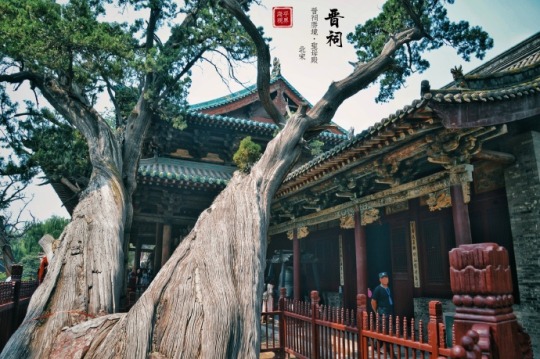
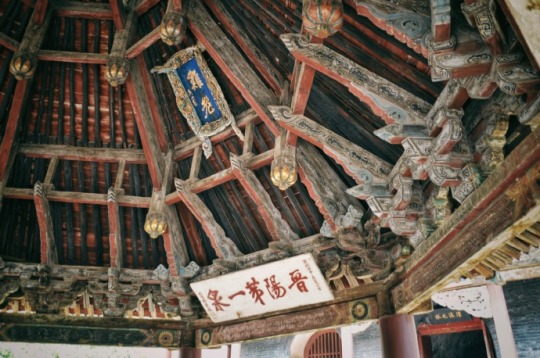
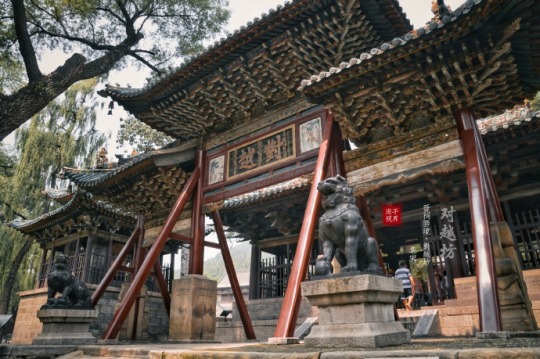




The Hall of the Holy Mother: One of the Oldest Places of Worship
The Hall of the Holy Mother (聖母殿) in Jinci Temple (晉祠), Shanxi. Built during the reign of Emperor Renzong (仁宗) of the Northern Song dynasty (1023-1032).
The hall is part of the ever evolving temple complex founded about one and a half thousand years ago. Over the centuries of countless transformations, it has accumulated buildings of various periods and styles.
The temple is dedicated to Shuimu (水母), The Old Mother of Waters, witch-goddess of Chinese lore, appearing in the form of a dragon, a snake or a charming lady with a sword and a yoke.
Photo: ©鱼雁江南, 雪夜魚舟
#ancient china#chinese culture#chinese mythology#taoism#chinese architecture#song dynasty#wooden architecture#wooden buildings#chinese customs#taoist#chinese folk religion#chinese temple#religious art#temple architecture#taoist deities#goddess#goddess worship#mother goddess#great mother#chinese folklore#dragon art#dragon
250 notes
·
View notes
Text
One for Heaven and Earth by cerbykerby

One for Heaven and Earth
by cerbykerby (@cerbykerby)
T, 7k, Wangxian
Summary: An incredulous "Whoa," behind Lan Wangji yanks him out of his meditative state. He spins around fast enough for his wet hair to stick to his cheek. His eyes widen in horror.
On the shore of the Cold Springs, Wei Wuxian stands, half-dressed in his own robes. He holds up Lan Wangji's heavenly robe, the fabric shining like spilled stars at midnight.
"Lan Zhan," Wei Wuxian breathes, a whole constellation reflecting in his eyes. "What's this? It's so—"
----------
On the night Lan Wangji's mother left, she gave him a divine robe and told him to never let anyone see or take it from him.
Kay's comments: Absolutely loved this re-telling of MDZS where Lan Wangji's mother was a heavenly maiden and made heavenly robes for him and his brother. A very creative look at the backstory between Lan Wangji's parents and I love the subtle ways it affected his relationship with Wei Wuxian as well. Beautifully written too!
Excerpt: The Gusu Lan forehead ribbon means self-restraint. It is not meant to be touched by anyone other than one's fated person. Only with one's fated person can one truly be free.
The heavenly robe is a gift bestowed on Lan Wangji by his mother. It is a status symbol as much as it is a part of his identity. Celestial blood flows through him. The robe is proof that he is entitled to walk among the heavens as he does on earth. To steal his robe would be to deny him his birthright. To even have permission to touch his robe would be a sign of complete trust.
A forehead ribbon from his father. A heavenly robe from his mother. Both hold heavy significance. Neither can be given away without careful consideration.
Which, to Lan Wangji's alcohol-riddled mind, is the perfect reason why Wei Wuxian should have both items.
pov lan wangji, canon divergence, madam lan lives, lan family feels, chinese mythology & folklore, fairy tale retellings, canon compliant, hurt/comfort, emotional hurt/comfort, grief/mourning, loss, angst with a happy ending, supernatural elements
~*~
(Please REBLOG as a signal boost for this hard-working author if you like – or think others might like – this story.)
#Wangxian Fic Rec#The Untamed#Wangxian#MDZS#Kay's Rec#March 2024#teen#short fic <15k#One for Heaven and Earth#cerbykerby#pov lan wangji#canon divergence#madam lan lives#lan family feels#chinese mythology & folklore#fairy tale retellings#canon compliant#hurt/comfort#emotional hurt/comfort#grief/mourning#loss#angst with a happy ending#supernatural elements
77 notes
·
View notes
Text

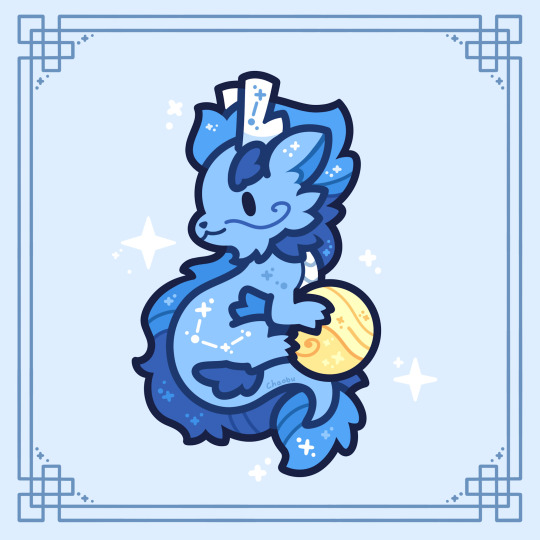
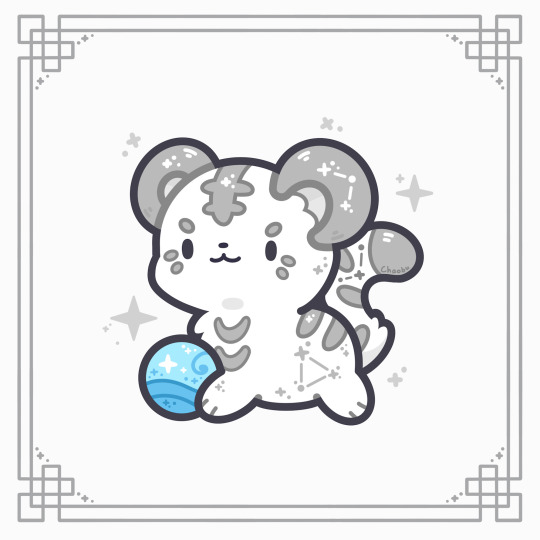
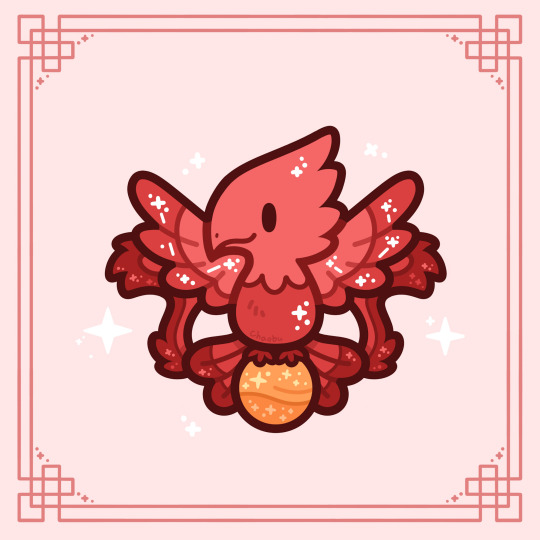

Creatures from Chinese mythology - Four Symbols addition (Black Tortoise, Azure Dragon, White Tiger, Vermillion Bird, Yellow Dragon) (2/3)
Black Tortoise: The Black tortoise of the North is connected to water and winter. It is associated with longevity and wisdom and is often depicted with a snake coiled around it, or as a tortoise-snake chimera.
Azure Dragon: The Azure Dragon guards the East. While most Chinese dragons are associated with water, the Azure Dragon is tied to the element of wood and the spring season.
White Tiger: The White Tiger of the West is associated with the element of metal and the autumn season. It fights against threats from both the mortal and spirit world.
Vermilion Bird: The Vermilion Bird of the South is associated with the element of fire and summer. It is a symbol of good luck and is often equated with the phoenix.
Yellow Dragon: The Yellow Dragon of the Center is the fifth member of the Four Symbols. It is associated with the element of earth and the changing of seasons.
#mythology#folklore#chinese mythology#azure dragon#dragon#yellow dragon#black tortoise#white tiger#vermilion bird
581 notes
·
View notes
Text
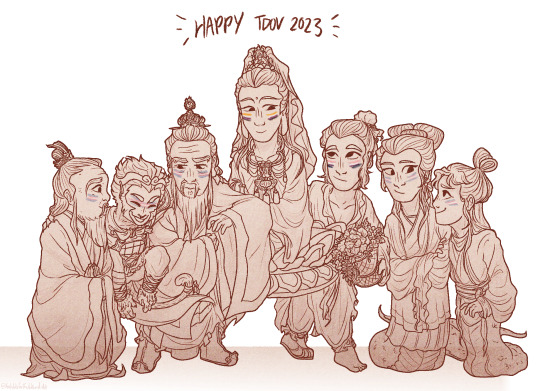
A little late but happy Trans Day of Visibility!!!
[ID: A monochrome chibi drawing of various figures from Chinese folklore with pride flags painted onto their faces. From left to right are Taibai Jinxing, Sun Wukong, Taishang Laojun, Guanshiyin Pusa, Lan Caihe, Bai Suzhen, and Qing She. Guanyin has nonbinary flags and Lan Caihe has genderfluid flags, but everyone else has trans flags. Above them is written "Happy TDOV 2023!" End ID]
#my art#tdov#tdov23#chinese mythology#journey to the west#jttw#xiyouji#sun wukong#monkey king#legend of the white snake#bai suzhen#qing she#xiao qing#wanna make it very clear that i am referring to folkloric deity taishang laojun not historical figure laozi. bc thatd be insane gfhdjkfdh#anyways no nezha this year bc i decided to go with only historic and/or reasonably textually supported characters ^-^#will add details in a reblog
426 notes
·
View notes
Text

The monkey king
#art#monkey king#the monkey king#journey to the west#jttw#china#chinese#chinese mythology#folklore#design#character design
240 notes
·
View notes
Text
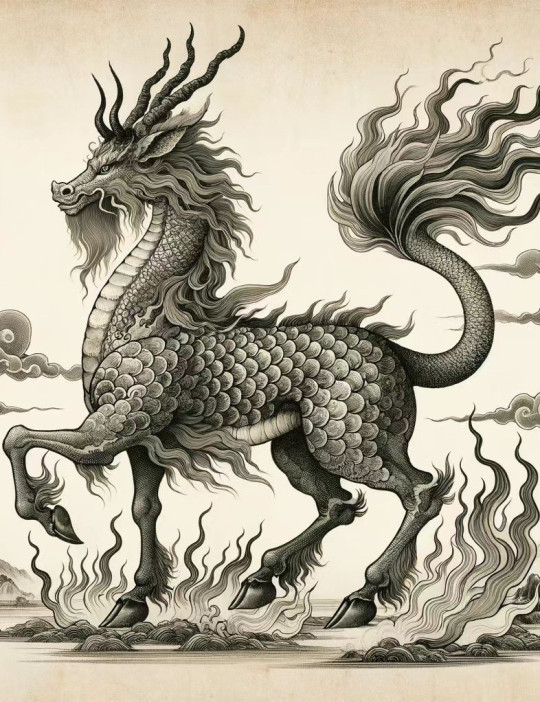
[Image above: Qilin, a legendary hoofed chimeric creature of Chinese mythology that is have been born from Yinglong]
Legends of the humanoids
Reptilian humanoids (7)
Yinglong - Winged Dragon, God of Rain in Chinese mythology
Yinglong (lit. 'responsive dragon') is a dragon that belonged directly to the Yellow Emperor (reign dates: 2697–2597 or 2698–2598 BCE), with four legs, bat- or falcon-like wings and three claws on each foot. It is allowed to access between heaven and earth. It also has the ability to store water and make it rain.
Yinglong is the chief of of the four dragons are the Azure, Red, White and Black dragons, and is said to give birth to the Heavenly Horse (Qilin), and become Yellow Dragon in old age. The Yellow Dragon is located in the middle of the Five Dragon King (Ref), is a part of Wuxing & the Four Symbols (Ref2) as the embodiment of the element of earth.
The (2nd century BCE) Huainanzi uses Yinglong in three chapters. "Forms of Earth" (Chapter 4) explains how animal evolution originated through dragons, with Yinglong as the progenitor of quadrupeds.
“All creatures, winged, hairy, scaly and mailed, find their origin in the dragon. The yu-kia (founder of birds) produced the flying dragon, the flying dragon gave birth to the phoenixes, and after them the luan-niao and all birds, in general the winged beings, were born successively. The mao-tuh ("hairy calf") produced the ying-lung the ying-lung (yinglong) gave birth to the kien-ma (heavenly horse), and afterwards the qilin and all quadrupeds, in general the hairy beings, were born successively. …”
Qilin are a type of legendary animal in Chinese mythology. They resemble deer in appearance, are large, standing 5 m ( approx. 16 ft) tall, and are unicorns with a face resembling a dragon, a bull's tail and horse's hooves, and qilin horns. Its back is five-coloured, its fur is yellow and it has scales on its body.

伝説のヒューマノイドたち
ヒト型爬虫類 (7)
応龍 〜 中国神話に登場する雨の神、翼のある龍
応龍 (インロン: “反応するドラゴン“の意) は、帝王である黄帝 (在位: 紀元前2697〜2597年または2698〜2598年) に直属する龍で、4本足で蝙蝠ないし鷹のような翼、足に3本の爪を持つ。天と地の間を行き来することができる。また、水を貯めて雨を降らせる能力もある。
応龍は、四龍の長あり、天馬 (麒麟) を生み、老いて黄龍になると言われている。
黄龍とは五方龍王(参照)の中央に位置しており、尚且つ四神 (四獣) の中心的存在、四神が東西南北の守護獣なのに対し、中央を守るとされる。土の要素を体現するものとして、五行思想と四神(参照2)の一部である。
紀元前2世紀の『淮南子』は、3つの章で応龍が使われている。 “地の形” (巻四地形訓) では、動物の進化が龍を通じてどのように起こったかを説明し、四足歩行の始祖は応龍であるとしている。
“翼のあるもの、毛のあるもの、鱗のあるもの、甲殻のあるもの、すべての生き物は龍に起源を持つ。羽嘉(うか: 鳥類の始祖) は飛竜を生み、飛竜は鳳凰を生み、その後に鸞鳥とすべての鳥類、一般的には翼を持つ生き物が次々と生まれた。毛犢 (もうとく: 獣類の始祖)は応龍を生み、応龍は天馬を生み、その後、麒麟とすべての四足動物、一般的には毛の生えた生き物が次々と生まれた。...“
麒麟とは、中国神話に現れる伝説上の動物の一種である。形は鹿に似て大きく背丈は5m あり、顔は龍に似て、牛の尾と馬の蹄をもち、麒角の一角生獣。背毛は五色に彩られ、毛は黄色く、身体には鱗がある。
#yinglong#yellow dragon#chinese mythology#qilin#yin yang#legendary creatures#hybrids#hybrid beasts#cryptids#therianthropy#legend#mythology#folklore#s.f.#nature#art
140 notes
·
View notes
Text
The hopeless romantic in me will never be able to resist a folklore in which a demon falls in love with a mortal and against all odds, they stay together.
#witches of color#mythologies#folklores#myths#chinese mythology#folkloric witch#folk tales#asian witch
251 notes
·
View notes
Text
I am presently preparing for final exams and wrapping up my final case studies for this semester, but I would like to share an opera that features Nezha outside of the widely known Havoc in Heaven where he is in combat with Sun Wukong. Today, we are going to discuss the opera Chentangguan (陳塘關), known also as The Birth of Nezha (哪吒出世) and Nezha Fights the Sea (哪吒鬧海).

The plot of this opera closely follows the origin story of Nezha as is featured within Canonization of the Gods. A defined year for when this opera was initially performed is unclear, though it was written by Xiao Rongchun and appeared within a registry of operas that featured a 'celebratory ascension' in 1824; an online record of this appears here from the Opera Culture Network.
Outside of Peking Opera, Qin Opera, Hui Opera, and Szechuan Opera also regard the performance as Nezha Fights the Sea whereas Hengqi Opera regards it as Golden Pagoda. The opera is present within Gui Opera, Hunan Opera, Chenhe Opera, and Handiao Erhuang (A form of folk opera exclusive to Shaanxi Province originating in 1807) though it is not as prominent.
This opera alongside it's contemporary art forms also focused heavily on the martial arts aspect of Chinese Opera in regards to Nezha and the varying methods his story was retold. Within this post is a brief taste of how this opera was performed, Nezha himself being played by Xu Yingying in this recording.
The full hour long performance can be found here, though it is not nearly as cinematic and was recorded from a considerable distance.
#nezha#li nezha#lmk nezha#monkie kid nezha#nezha 2019#the legend of nezha#third lotus prince#nezha lego monkie kid#nezha reborn#chinese opera#beijing opera#peking opera#chinese mythology#chinese folklore#chinese performing arts
103 notes
·
View notes
Text

The two at the beginning are dressed as (left-right) 财神/Caishen and 福星/Fuxing, gods of wealth and fortune/luck, respectively. 月老/Yue Lao, the matchmaker god is seen at the end. They are three gods from Chinese folk religion.
771 notes
·
View notes
Text
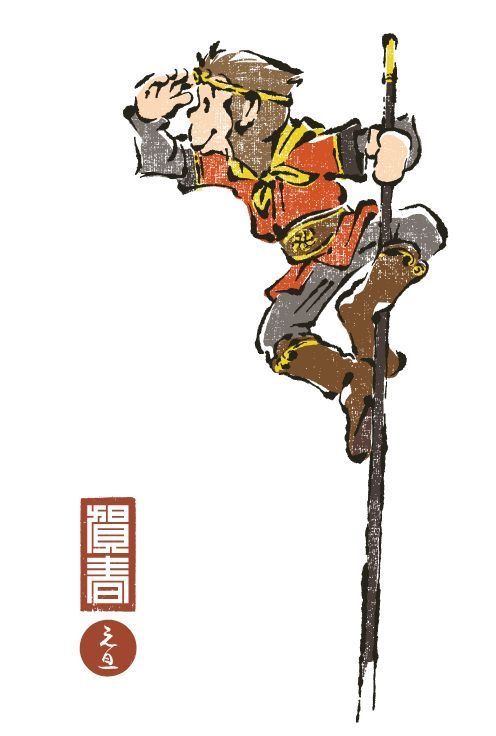
On the look out!
140 notes
·
View notes
Note
If let's say it is more characteristic that chinese dragons have the element of water? The fox spirits would be the fire? (once again, looking for Chinese fox spirits is difficult because sometimes I fear that the info will become more mixed with that of the Kitsune) What about tigers?
Yes, Chinese dragons are mainly associated with the Water element, and are weather deities, though Cold Dragons (freeze/chill) and Fire Dragons also exist, they are just a lot more rare.
Foxes do have association with Fire——not as strong as dragons and Water, but there are neat tidbits here and there. For example, in You Yang Za Zu, the same passage that mentioned foxes wearing human skulls on their heads in order to transform also said that, when foxes swung their tails around at night, fire comes out (夜击尾火出).
Vol. 448 of Taiping Guangji also mentioned a fox demon who had flames on its tail, "like a shooting star". In FSYY Pinghua, when Bi Gan shot an arrow at what appeared to be Daji in fox form, fire also came out when it connected.
The fox lady in the Qing dynasty 狐狸缘, while she was battling with Lv Dongbin, also spat out her "golden core" together with a stream of Samadhi Fire in an attempt to hurt him. Which is reminiscent of the more fire-like depiction of a fox's inner core.
However, there are other more obscure sources that associate foxes with the Earth element ('cause they dig holes and are yellow/orange colored?), and because Fire births Earth, you can light 1000 years old dead wood on fire, and the fire would lure the fox out and reveal its true form.
Also, one of the spells that's commonly used to subdue foxes and demons in general is the Five Thunder Arts (五雷法), where Daoists called upon the Thunder Bureau to strike their targets with fire and lightning.
I'm not as familiar with tiger yaoguais, but element-wise, the White Tiger of the West is associated with Metal, and in the Book of Mountains and Seas, Queen Mother of the West was said to have a leopard's tail + tiger's teeths, before she evolved into a more human form in later sources.
Tigers in folklore are more well-known for their ability to command ghosts, though. Specifically, ghosts of people they ate, who help lure in more preys for them, called 伥鬼.
38 notes
·
View notes
Text

The Sultan orders to cut off Aladdin's head by Albert Robida
#aladdin#scimitar#art#albert robida#illustration#aladdin and the wonderful lamp#one thousand and one nights#1001 nights#arabian nights#folklore#folk tales#fairy tales#chains#sword#oriental#middle eastern#executioner#swords#folk tale#hanna diyab#china#chinese#the book of the one thousand and one nights#the arabian nights#antoine galland#mythology#asia#asian#sultan
45 notes
·
View notes
Text



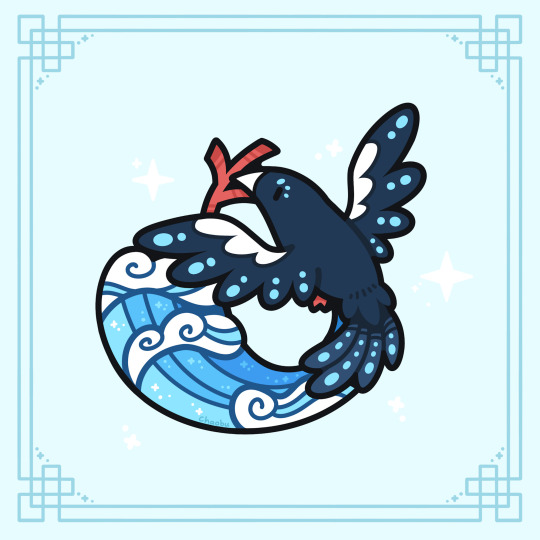

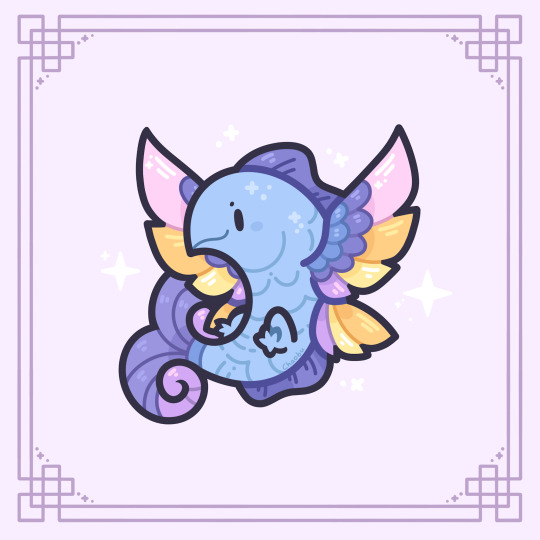
Creatures from Chinese mythology - Four Symbols addition (Lion Dance, Dijiang, Jingwei, Jian Birds, Peng) (3/3)
Lion Dance: One of the many myths associated with the Lion Dance is the tale of the Nian. In ancient times, a beast called the Nian would descend upon villages every year, devouring crops and people. The Lion Dance (along with firecrackers and the color red) was used to drive away the Nian, allowing the villagers to live in peace for another year.
Dijiang: Dijiang is a creature with no face and six legs. It lives in a state of perpetual confusion. Despite this, it is very fond of singing and dancing. Some sources describe it as a divine bird.
Jingwei: Jingwei was a girl that drowned at sea, and her spirit was reincarnated as a bird. She tirelessly throws sticks and stones into the sea to fill it up so that no one would have to suffer the same fate she did.
Jian Birds: The Jian is a mythical one-eyed, one-winged bird. In order to fly, a Jian needs to find a partner Jian. Paired Jian birds are known as Jianjian.
Peng: Peng, sometimes called Dapeng,are birds with wingspans thousands of miles wide. They can take the form of an equally enormous fish known as Kun.
462 notes
·
View notes